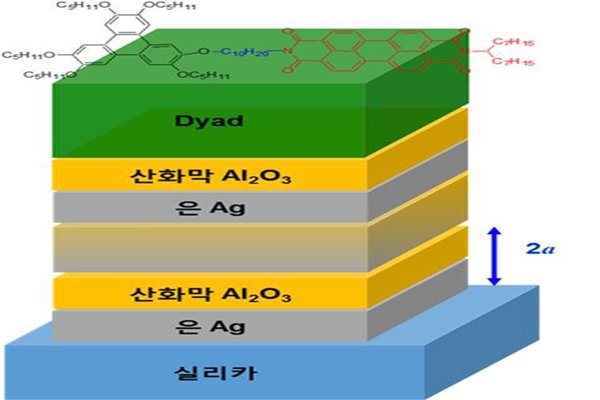South Korean research team has developed a technology that increases organic photoelectric element’s efficiency in generating electricity by using ‘metamaterial’ that is smaller than wavelength of light. This technology can be used to overcome limitations of materials and processes in next-generation solar battery, display, and semiconductor transistor fields.
Research team led by Professor Woo Jung-won of Ewha Womans University made an announcement on the 12th that it has developed an original technology that increases photoelectric element’s efficiency in generating electricity by controlling charge transfer with metamaterial.
Metamaterial is an artificial structure that is designed smaller than wavelength of light. Because it has characteristics that cannot be implemented by natural materials, it can implement innovative technologies such as ‘transparent cape’.
Research team utilized metamaterial with thickness of 10nm, which is about 70 times thinner than wavelength of light, and has silver and oxide stacked on it. Molecule that is coated on top of this material can voluntarily control charge transfer.
Time constant of ‘exciton’ that creates current through light increases when dielectric constant that is around molecule is lowered. Time constant is a time when an exciton is separated into an electron and an electron hole.
Research team was able to increase time constant of an exciton by three times just by controlling charge transfer with metamaterial and without any complicated process. Photoelectric element’s efficiency in generating electricity becomes higher as time constant of an exciton becomes longer.

Previously optical design technology that controls element’s structure was used before to increase photoelectric element’s efficiency. However it was difficult to actually implement this technology and it was difficult to have stable efficiency as this technology is sensitive to structure of an element.
It is expected that this research will push forward commercialization of organic solar batteries. Compared to 1st generation silicon batteries and 2nd generation thin-film batteries, it is easier to manufacture organic solar batteries and #there are varieties of materials. Improvement in efficiency in electricity generation is faster and they can be developed as flexible devices. Previously, they had had low efficiency and short lifespans.
When metamaterial is applied to organic solar batteries, it is possible to control movement of electrons without using complicated technologies like before and to improve efficiency and lifespan. Because it is a new method that voluntarily controls charge transfer, it can be applied to variety of fields.
“We have proposed world’s first method that actively controls charge transfer that occurs within molecules that are stacked on top of metamaterial.” said Professor Woo. “It is an original technology that can be used for IoT (Internet of Things) sensors, displays, and solar batteries and it can also be used to control organic elements that are applied to flexible energy elements.”
This research was published on an international scientific journal called ‘Nature Materials’. This research was carried out through Ministry of Science, ICP and Future Planning’s Global Frontier Project (Center for Advanced Meta-Materials), Foreign Excellent Research Organization Luring Project (CNRS-Ewha International Research Center), and Leading Research Center Project (Quantum Metamaterial Research Center).
Staff Reporter Song, Junyoung | songjy@etnews.com